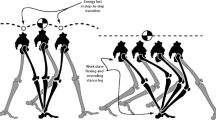Abstract
The safe control of walking over different terrains requires appropriate adaptations in the dynamic and kinematic limb patterns. To date, the study of locomotor dynamics in the cat has been confined to level, unobstructed walking. The present study extends the work of Lavoie et al. by applying linked segment analyses to estimate muscle contributions to torque and mechanical power at the hindlimb joints of two female cats during both unobstructed walking and obstacle avoidance. Data during obstacle avoidance were analyzed both when the hindlimb led in clearance and was farthest from the obstacle, and when it trailed in clearance and was closest or near to the obstacle. It was found that, in both the Far and Near obstructed conditions, the cats cleared the obstacles primarily by increasing the knee flexor torque already used during unobstructed gait. Contributions from the hip and ankle muscle groups were more variable. There was more emphasis on the hip extensors in mid to late stance, and the hip flexors generated a small amount of energy at paw-lift in the Far condition. In the Near condition, the hip extensors were employed to control hip flexion. We suggest that hip flexor generation power in mid-swing contributes to the clearance of the upcoming obstacle in the Far condition while, in the Near condition, hip flexion advances the already extended limb ahead of the obstacle. The ankle was actively dorsiflexed in the Near condition but was maintained in extension in the Far condition. The emphasis on active knee flexor control by the cat to avoid obstacles, as well as the dependence of ankle control on obstacle proximity, is similar to strategies seen for humans. However, the knee flexor strategy is innate to the cat’s normal level walking control, whereas in humans active knee flexion at toe-off requires a reorganization from level, non-obstructed gait.
Similar content being viewed by others
Author information
Authors and Affiliations
Additional information
Received: 2 February 1998 / Accepted: 21 September 1998
Rights and permissions
About this article
Cite this article
McFadyen, B., Lavoie, S. & Drew, T. Kinetic and energetic patterns for hindlimb obstacle avoidance during cat locomotion. Exp Brain Res 125, 502–510 (1999). https://doi.org/10.1007/s002210050708
Issue Date:
DOI: https://doi.org/10.1007/s002210050708




